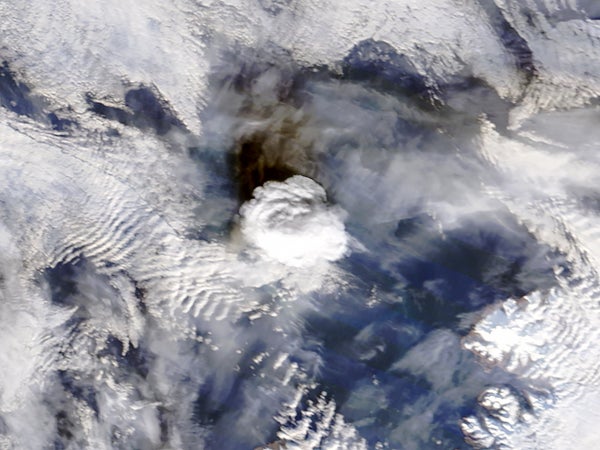Volcanoes often signal they are about to blow their tops days or even months in advance. Seismic activity or sulfurous gases indicate red-hot magma is nearing the surface, for example. However, Bogoslof, a volcanic island in the Aleutians off the southwest coast of Alaska exploded without any warning last Saturday. This was its 40th eruption since December 2016, of which 75 percenthave not been predicted by the U.S. Geological Survey’s Alaska Volcano Observatory (AVO). The most recent event sent a plume of ash and smoke more than six miles into the atmosphere. Ash at this height can ruin the engines of jet airplanes flying this well-traveled route between Asia and North America.
Scientific American asked Michelle Coombs, a research geologist and scientist in charge at the AVO, why Bogoslof is so temperamental, and whether volcanologists will be able to say when the dangerous volcano will go off again.
[An edited transcript of the interview follows.]
On supporting science journalism
If you're enjoying this article, consider supporting our award-winning journalism by subscribing. By purchasing a subscription you are helping to ensure the future of impactful stories about the discoveries and ideas shaping our world today.
Why can’t you tell when Bogoslof is about to erupt?
Bogoslof is a tiny island, less than one kilometer across, and 50 kilometers away from the nearest island with monitoring equipment. It’s a very sensitive area for marine wildlife; it’s a seabird and marine mammal habitat, and a U.S. Fish and Wildlife Service [FWS] wilderness area. Even if we had put instruments directly on Bogoslof prior to December, they would simply have been destroyed because the island is so small.
Can you track eruptions after they start, despite the remoteness?
We are trying to be more creative in our monitoring effort. For example, last week we put in a couple of hydrophones. Those track seismic waves that are moving through the water column. Because Bogoslof is an island volcano, when it erupts it produces energy that moves through the ocean. We use infrasound sensors to measure sound waves in the air during explosions and we’ve also installed new lightning sensors. When volcanos erupt, especially in a very wet environment, the ash cloud can produce a lot of volcanic lightning.
How quickly can you detect an eruption and warn aircraft?
Typically, we first receive automated text messages from the seismic or infrasound sensors on nearby islands. An analyst looks at the data to see if there is truly eruptive activity or if the alarm is a false positive. We sometimes also get automated alarms of lightning strokes.
Within minutes, at most, we will notify the Federal Aviation Administration and National Weather Service by phone. Luckily, it often takes some minutes, to tens of minutes, before a volcanic cloud will reach altitudes that are hazardous to aviation. At this point we will have analysts looking at geophysical and satellite data, and others running an ash-dispersion model. Tracking the cloud and ongoing activity can go on for several hours or days.
How have dozens of eruptions affected the island?
We’ve been tracking the changing shape of the island using high-res satellite images, the kind you might see on Google Earth. It’s a battle—a competition between creation and destruction. The volcano has been growing in size because material erupts and gets deposited on its flanks. But occasionally an eruption will blow out and destroy some of the new land. Wave action from the Bering Sea is also destroying the new deposits. The island has gotten bigger but we don’t think that will last for very long, because erosion will eat it away.
Can you predict how long the current cycle of activity will go on?
We don’t know. But Bogoslof has had nine eruption [periods] in historic times, lasting anywhere from three weeks to two years. Based on that record, we think that this eruption could go for several more months, maybe even a couple of years.
Bogoslof was home to thousands of birds, sea lions and fur seals. What has happened to them?
Typically, animals adapt pretty well. [Those not killed in the initial eruption swim or fly to a nearby island, then come back.] The eruptions started in December, a month when not that many animals are on the island. But in March, even with regular eruptive activity, we saw evidence that some marine mammals were returning to have their young.
The FWS usually visits Bogoslof annually, but because of the ongoing eruption that is not going to happen this year. The FWS and the National Oceanic and Atmospheric Administration are planning some remote surveys instead, with satellite imagery and maybe using drones from offshore to get an idea what the animals are doing.
